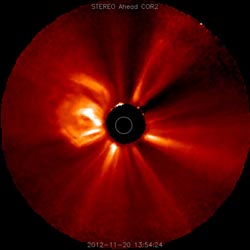NASA Spacecraft Observe Nov. 20 Solar Eruption

NASA's Solar Terrestrial Relations Observatory (STEREO) captured this image of a coronal mass ejection on Nov. 20, 2012 at 8:54 a.m. EST, about two hours after it left the sun. Credit: NASA/STEREO<br>
Experimental NASA research models, based on observations from the Solar Terrestrial Relations Observatory (STEREO), show that the Nov. 20 CME left the sun at speeds of 450 miles per second, which is a slow to average speed for CMEs.
CMEs can cause a space weather phenomenon called a geomagnetic storm, which occurs when CMEs successfully connect up with the outside of the Earth's magnetic envelope, the magnetosphere, for an extended period of time.
In the past, CMEs of this speed have not usually caused substantial geomagnetic storms. They have caused auroras near the poles but are unlikely to cause disruptions to electrical systems on Earth or interfere with GPS or satellite-based communications systems.
NOAA's Space Weather Prediction Center (http://swpc.noaa.gov) is the United States government's official source for space weather forecasts.
What is a CME?
For answers to this and other space weather questions, please visit the Spaceweather Frequently Asked Questions page:
http://www.nasa.gov/mission_pages/sunearth/spaceweather/index.html
Karen C. Fox
NASA's Goddard Space Flight Center, Greenbelt, Md.
Media Contact
All latest news from the category: Physics and Astronomy
This area deals with the fundamental laws and building blocks of nature and how they interact, the properties and the behavior of matter, and research into space and time and their structures.
innovations-report provides in-depth reports and articles on subjects such as astrophysics, laser technologies, nuclear, quantum, particle and solid-state physics, nanotechnologies, planetary research and findings (Mars, Venus) and developments related to the Hubble Telescope.
Newest articles

A universal framework for spatial biology
SpatialData is a freely accessible tool to unify and integrate data from different omics technologies accounting for spatial information, which can provide holistic insights into health and disease. Biological processes…

How complex biological processes arise
A $20 million grant from the U.S. National Science Foundation (NSF) will support the establishment and operation of the National Synthesis Center for Emergence in the Molecular and Cellular Sciences (NCEMS) at…

Airborne single-photon lidar system achieves high-resolution 3D imaging
Compact, low-power system opens doors for photon-efficient drone and satellite-based environmental monitoring and mapping. Researchers have developed a compact and lightweight single-photon airborne lidar system that can acquire high-resolution 3D…





















